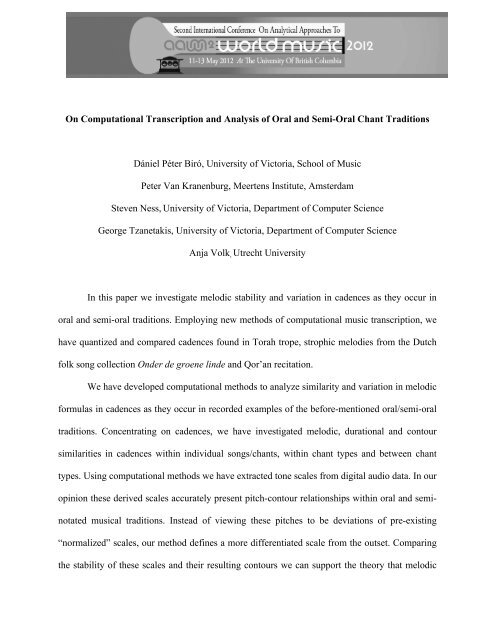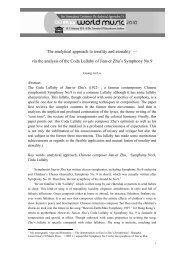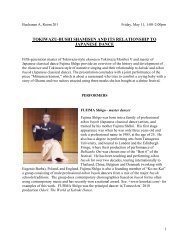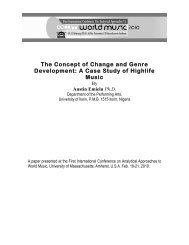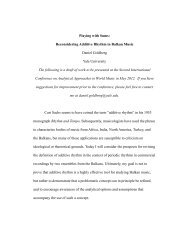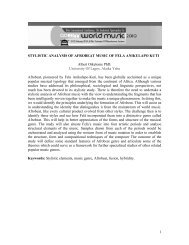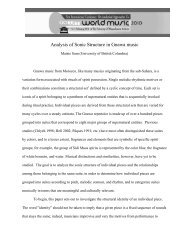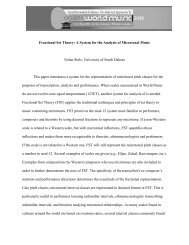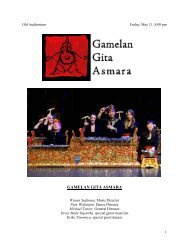On Computational Transcription and Analysis of Oral and Semi-Oral ...
On Computational Transcription and Analysis of Oral and Semi-Oral ...
On Computational Transcription and Analysis of Oral and Semi-Oral ...
Create successful ePaper yourself
Turn your PDF publications into a flip-book with our unique Google optimized e-Paper software.
<strong>On</strong> <strong>Computational</strong> <strong>Transcription</strong> <strong>and</strong> <strong>Analysis</strong> <strong>of</strong> <strong>Oral</strong> <strong>and</strong> <strong>Semi</strong>-<strong>Oral</strong> Chant Traditions<br />
Dániel Péter Biró, University <strong>of</strong> Victoria, School <strong>of</strong> Music<br />
Peter Van Kranenburg, Meertens Institute, Amsterdam<br />
Steven Ness, University <strong>of</strong> Victoria, Department <strong>of</strong> Computer Science<br />
George Tzanetakis, University <strong>of</strong> Victoria, Department <strong>of</strong> Computer Science<br />
Anja Volk , Utrecht University<br />
In this paper we investigate melodic stability <strong>and</strong> variation in cadences as they occur in<br />
oral <strong>and</strong> semi-oral traditions. Employing new methods <strong>of</strong> computational music transcription, we<br />
have quantized <strong>and</strong> compared cadences found in Torah trope, strophic melodies from the Dutch<br />
folk song collection <strong>On</strong>der de groene linde <strong>and</strong> Qor’an recitation.<br />
We have developed computational methods to analyze similarity <strong>and</strong> variation in melodic<br />
formulas in cadences as they occur in recorded examples <strong>of</strong> the before-mentioned oral/semi-oral<br />
traditions. Concentrating on cadences, we have investigated melodic, durational <strong>and</strong> contour<br />
similarities in cadences within individual songs/chants, within chant types <strong>and</strong> between chant<br />
types. Using computational methods we have extracted tone scales from digital audio data. In our<br />
opinion these derived scales accurately present pitch-contour relationships within oral <strong>and</strong> seminotated<br />
musical traditions. Instead <strong>of</strong> viewing these pitches to be deviations <strong>of</strong> pre-existing<br />
“normalized” scales, our method defines a more differentiated scale from the outset. Comparing<br />
the stability <strong>of</strong> these scales <strong>and</strong> their resulting contours we can support the theory that melodic
stability in Ashkenazi Torah trope cadences is more prevalent than in Sephardic equivalents. We<br />
have discovered relationships between variational embellishment <strong>and</strong> contour stability within<br />
cadences in Indonesian <strong>and</strong> Dutch-Indonesian Qor’an recitation. We are currently applying<br />
similar methods <strong>of</strong> comparison within Dutch folk song examples.<br />
By developing computational models for cadences in these three chant types we<br />
contribute to extending possibilities for musical transcription. Employing computational tools<br />
that allow for a more objective transcription, we strive to reduce the subjective bias <strong>of</strong> the<br />
ethnomusicologist. While transcription methodologies have been subject to debate we find that<br />
this new form <strong>of</strong> computational transcription presents new means for cross-cultural music<br />
analysis, thereby extending the practice <strong>of</strong> transcription into the modern world.


